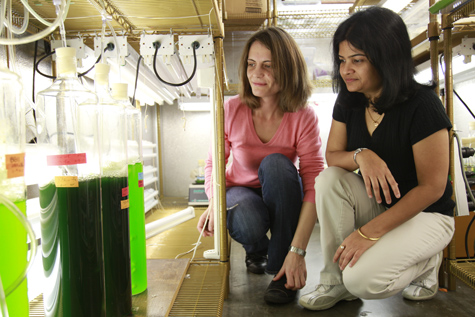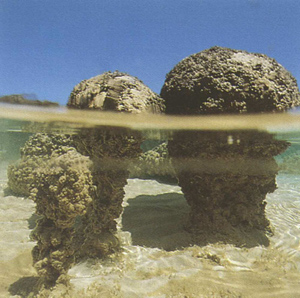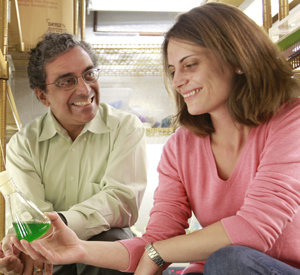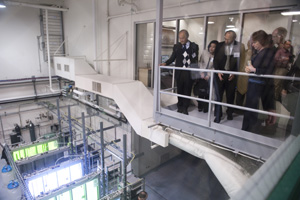
A small cabinet the size of a dorm refrigerator sits in one of the labs of Himadri B. Pakrasi, PhD, the George William and Irene Koechig Freiberg Professor of Biology in Arts & Sciences and professor of energy in the School of Engineering & Applied Science at Washington University in St. Louis. Inside, a blue-green soup percolates in thick glass bottles under the cool light of red, blue and green LEDS.
This isn’t just any soup, however. It is a soup of champions.
The soup is colored by a strain of blue-green bacteria that bubble off roughly 10 times the hydrogen gas produced by their nearest competitors — in part because of their unique genetic endowment, but also in part because of tricks the scientists have played on their metabolism.
Hydrogen gas can be produced by microbes that have enzymes called hydrogenases that take two hydrogen ions and bind them together. Although the soup microbes have hydrogenases, most of the hydrogen they evolve is a byproduct instead of an exceptionally efficient nitrogenase, an enzyme that converts the nitrogen in air to a nitrogen-containing molecule the microbes can use.
The microbe’s gas-producing feat is described in the Dec. 14, 2010, issue of the online journal Nature Communications.
An ancient microbe that evolved under harsh conditions
Biohydrogen, like that bubbling up from the microbial soup, is one of the most appealing renewable energy fuels. Produced by splitting water with energy from the sun, it releases mostly water when it burns. It’s hard to get any cleaner than that.
The strain growing in the Roux bottles in the cabinet, called Cyanothece 51142, originally was found in the Gulf of Mexico by Louis A. Sherman, PhD, of Purdue University, one of the article’s authors. Its genes were sequenced in 2008 at the Genome Sequencing Center at Washington University School of Medicine.

Wikipedia Commons
Otherworldly formations in Shark Bay, Australia, suggest what the planet may have looked like 2.5 billion years ago when cyanobacteria were one of the few organisms in residence. The formations, called stromatalites, consist of sand and sediment trapped in biofilms of cyanobacteria.
Cyanothece 51142 may be new to science, but cyanobacteria, the group of organisms to which it belongs, have existed for at least 2.5 billion years, Pakrasi says. These ancient organisms have had to survive a variety of chemical environments and have the metabolic tricks to show for it.
All cyanobacteria have the ability to fix carbon from the atmosphere, stuffing it away in starch or glycogen, but Cyanothece is among the rarer strains that also can fix nitrogen, converting atmospheric nitrogen to ammonia and eventually to larger nitrogen-rich molecules.
Because it can fix both carbon and nitrogen, Cyanothece, when conditions warrant, can survive on air, water and sunlight alone. It is about as self-reliant as an organism can be.
There is one catch. Nitrogenase is very sensitive to oxygen and so carbon fixing (photosynthesis), which produces oxygen as a byproduct, has to be separated from nitrogen-fixing in some way.
Oxygen by day, hydrogen by night
Cyanothece accomplishes this by time division; it has an internal biological clock that establishes a circadian rhythm. (Cyanobacteria are the only prokaryotes — organisms without nuclei — that have a clock.)
So Cyanothece fixes carbon glycogen molecules during the day, producing oxygen as a byproduct, and it fixes nitrogen in ammonia during the night, producing hydrogen as a byproduct. For every nitrogen molecule that’s fixed, Pakrasi says, one hydrogen molecule is produced.
Each half of the cycle powers the other. The glycogen produced in the day is consumed in the energy intensive process of fixing nitrogen at night. The fixed nitrogen produced at night is used to make nitrogen-containing proteins during the day.
Pakrasi, who also is the director of I-CARES, the International Center for Advanced Renewable Energy and Sustainability, calls the microbes biobatteries because they store daytime energy for use at night and nighttime energy for use in the day.
The separation in time prevents the two metabolic processes from competing with one another. At night, the bacteria begin to metabolize the glycogen (or respire). Quickly consuming intracellular oxygen, respiration creates the oxygen-free or anoxic conditions inside the bacteria the nitrogenase needs to do its work.

Whitney Curtis
Himadri Pakrasi, PhD (left), the George William and Irene Koechig Freiberg Professor of Biology in Arts & Sciences, and Jana Stöckel, PhD, with a culture of Chorella vulgaris, otherwise known as green algae. This algae has talents of its own, but hydrogen production is not among them.
Cyanothece’s clock is set by the environmental cue of changing light levels. But once entrained by the day/night cycle, the clock continues to run even in the absence of the cues.
Just as a prisoner kept in solitary confinement will maintain a roughly 24-hour sleep/wake cycle, Cyanothece will continue to fix nitrogen even if it is incubated under continuous light.
As Pakrasi puts it, the entrained microbes are still experiencing “subjective dark” for 12 hours of the day.
More strangely, entrained Cyanothece incubated under continuous light evolve more hydrogen than those cycling between light and dark. This is probably because the energy in light somehow fuels the energy-intensive nitrogenase reaction, says Anindita Banerjee, PhD, (who also goes byBandyopadhyay), a postdoctoral fellow in Pakrasi’s lab. The scientists are still trying to understand exactly why this happens.
Feeding the beast
In addition to keeping the microbes awake all night, the scientists have another trick up their lab coat sleeves. Cyanothece can survive on the starvation diet of sunlight and air, but adaptable microbe that it is, it also can live on carbon-containing molecules or on a mix of sunlight and carbon-containing molecules.
The scientists found that the microbes produced more hydrogen if they were grown in cultures that contained glycerol, a colorless, sweet-tasting molecule that is frequently used as a food additive.
The additional carbon in the glycerol revs up the nitrogenase to meet the increased demand for nitrogen in the cells, Pakrasi says. And the more active the nitrogenase, the more hydrogen is produced.
Despite journalistic hype, Pakrasi warns, hydrogen is not the fuel of tomorrow. It is hard to transport and its energy density is too low. The fuel tank for a semi-trailer powered by hydrogen would take up half the trailer, he says.

What intrigues Pakrasi about the microbes is not their utility but rather their ingenuity. Their unique metabolism gives them the ability to produce hydrogen, a clean fuel, while disposing of two wasteproducts: glycerol, a copious byproduct of biodiesel production, and carbon dioxide, a waste product from coal-fired power plants.
“They give you a lot of bang for your buck,” he says.
Cyanothece may soon be moving — from cramped flasks in Pakrasi’s lab to the giant bioreactors in WUSTL’s Advanced Coal and Energy Research Facility. There, scientists will be able to monitor their every metabolic move as they feast on carbon-dioxide-rich flue gas from the site’s combuster and bubble up hydrogen.
These studies were funded by the Office of Science of the U.S. Department of Energy.